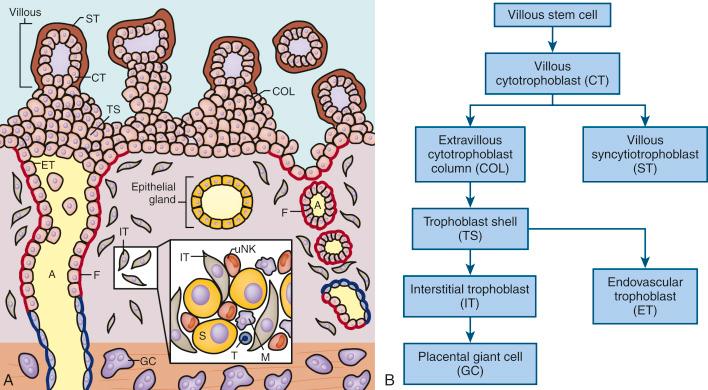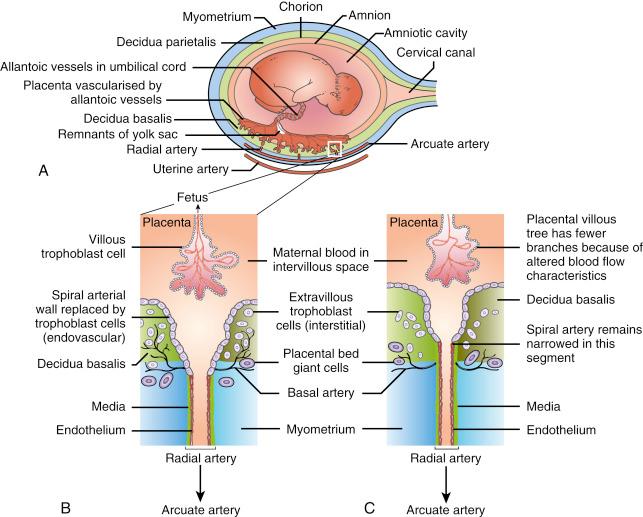Physical Address
304 North Cardinal St.
Dorchester Center, MA 02124
The extravillous pathway of trophoblast differentiation is essential for the development of the fetoplacental blood supply.
As they invade into the maternal decidua, extravillous trophoblast cells express a unique array of human leukocyte antigen (HLA) class I molecules, HLA-G, HLA-E and HLA-C.
The main population of maternal immune cells in the decidua during placentation are uterine natural killer (uNK) cells.
Interaction between polymorphic killer immunoglobulin-like receptors (KIRs) on maternal uNK cells and their HLA-C ligands on fetal trophoblast cells may regulate the depth and extent of vascular modification by trophoblast.
KIR–HLA-C interactions resulting in uNK inhibition are associated with reduced trophoblast invasion and increased risk for the great obstetric syndromes (GOS): pre-eclampsia, stillbirth and fetal growth restriction.
Conversely, KIR–HLA-C interactions that activate uNK are associated with increased birth weight and higher risk for obstructed labour. Hence, the maternal immune system plays a role in regulating human birth weight.
The traditional way to study pregnancy immunology follows the classical transplantation model, which views the fetus as an allograft. A more recent approach focuses on the unique, local uterine immune response to the implanting placenta. This requires a detailed knowledge of implantation and placental structure because this impacts greatly on the type of immune response produced by the mother. At the implantation site, cells from the mother and the fetus intermingle during pregnancy. Unravelling what happens here is crucial to our understanding of why some human pregnancies are successful but others are not.
The invasive implantation undertaken by the human embryo brings fetally derived trophoblast cells into direct contact with maternal cells in the uterine mucosa. Initial contact is followed by adhesion between the embryonic trophectoderm of the blastocyst and the uterine surface epithelium. As the blastocyst penetrates through the surface epithelium into the uterine mucosa, this trophectoderm layer differentiates into an outer multinucleated syncytiotrophoblast (primitive syncytium) and an inner layer of primitive mononuclear cytotrophoblast. Lacunae soon appear in the syncytium, and these rapidly enlarge by fusing with each other. The uteroplacental circulation is potentially established when this lacuna system erodes through the uterine capillaries. The intervillous space of the definitive placenta is a derivation of these lacunae.
The subsequent differentiation of trophoblast occurs along two main pathways, villous and extravillous ( Fig. 6.1 ). Villous trophoblast is in contact with maternal blood in the intervillous space, and its main functions are transport of nutrients and oxygen to the fetus and secretion of hormones. In contrast, extravillous trophoblast is involved in the establishment of the placental blood supply and intermingles with maternal uterine tissues. At the tips of some chorionic villi, cytotrophoblast cells proliferate into cytotrophoblast columns that anchor these villi to the underlying decidua. From these columns, individual trophoblast cells break off to invade the decidua. These interstitial extravillous trophoblast cells appear to move towards the decidual spiral arteries, encircling these vessels, which then show endothelial swelling and a characteristic ‘fibrinoid’ destruction of the smooth muscle of the media. How trophoblast cells induce these changes in the vessel wall is unknown. When migrating trophoblast cells reach the decidual–myometrial junction, many become multinucleated placental bed giant cells. These can be regarded as the endpoint of the extravillous pathway of trophoblast differentiation.

Cytotrophoblast columns that lie over the openings of the decidual spiral arteries form a plug of cells that are known as endovascular trophoblast. Early in gestation, these plugs occlude the lumen of the vessels (see Fig. 6.1A ). This limits the influx of blood in the first trimester so that there is only seepage of serum into the intervillous space. This means that early in pregnancy, the embryo in the first trimester exists in a low-oxygen environment. From these plugs, some endovascular trophoblasts move down the inside of the artery, replacing the endothelium, and become incorporated into the vessel wall. At around 10 weeks of gestation, the endovascular plugs disperse, and maternal blood flow to the intervillous space is established.
Transformation of the spiral arteries by trophoblast is crucial to successful implantation because these changes convert the arteries from muscular vessels into flaccid sacs capable of transmitting the increased blood flow required for the developing fetoplacental unit. Failure of this arterial transformation will result in reduced conductance and poor perfusion of the placenta, which will affect the development of the villous tree. This in turn will lead to clinical conditions such as miscarriage, stillbirth, fetal growth restriction and pre-eclampsia ( Fig. 6.2 ).

Become a Clinical Tree membership for Full access and enjoy Unlimited articles
If you are a member. Log in here